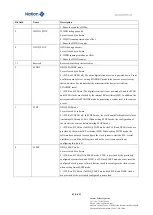
Nations Technologies Inc.
Tel
:
+86-755-86309900
:
info@nationstech.com
Address: Nations Tower, #109 Baoshen Road, Hi-tech Park North.
Nanshan District, Shenzhen, 518057, P.R.China
625
/
631
Table 27-1 Debug port pin
Debug port
Pin allocation
JTMS/SWDIO
PA13
JTCK/SWCLK
PA14
JTDI
PA15
JTDO
PB3
NJTRST
PB4
When both JTAG debugging interface and SWD debugging interface are enabled, the 5-wire JTAG debugging
interface will be used by default after reset.
When using JTAG interface, users can not use NJTRST pin. In this case, NJTRST pin (PB4, internal hardware
pull-up) can be used as a general-purpose GPIO.
When SWD interface is used, three pins JTDI (PA15), JTDO (PB3) and NJTRST (PB4) can be used as general
GPIO.
When the debugging function is not used, the above five pins can be used as general-purpose GPIO.
MCU debug function
Low-power mode debug support
N32G43x provides various low-power modes (See chapter Power control (PWR)for details). By default, if the MCU
enters SLEEP, STOP2, or STANDBY mode while the application is using the debug feature, the debug connection
will be lost. When debugging, make sure that the FCLK and HCLK of the core are turned on, and provide the
necessary clock for the core debugging. Users can perform software debugging in low power mode according to
specific operations.
To do this, a debugger or software first needs to configure the debug control registers associated with the low power
modes:
DBG_SLEEP mode:
The DBG_CTRL.SLEEP bit needs to be configured to provide HCLK with the same clock as provided to FCLK
(ie: the original configured system clock).
DBG_STOP mode:
The DBG_CTRL.STOP bit needs to be configured to start the internal RC oscillator to provide the clock for
HCLK and FCLK.
DBG_STANDBY mode:
The DBG_CTRL.STDBY bit needs to be configured to start the internal RC oscillator to provide the clock for
HCLK and FCLK.







































